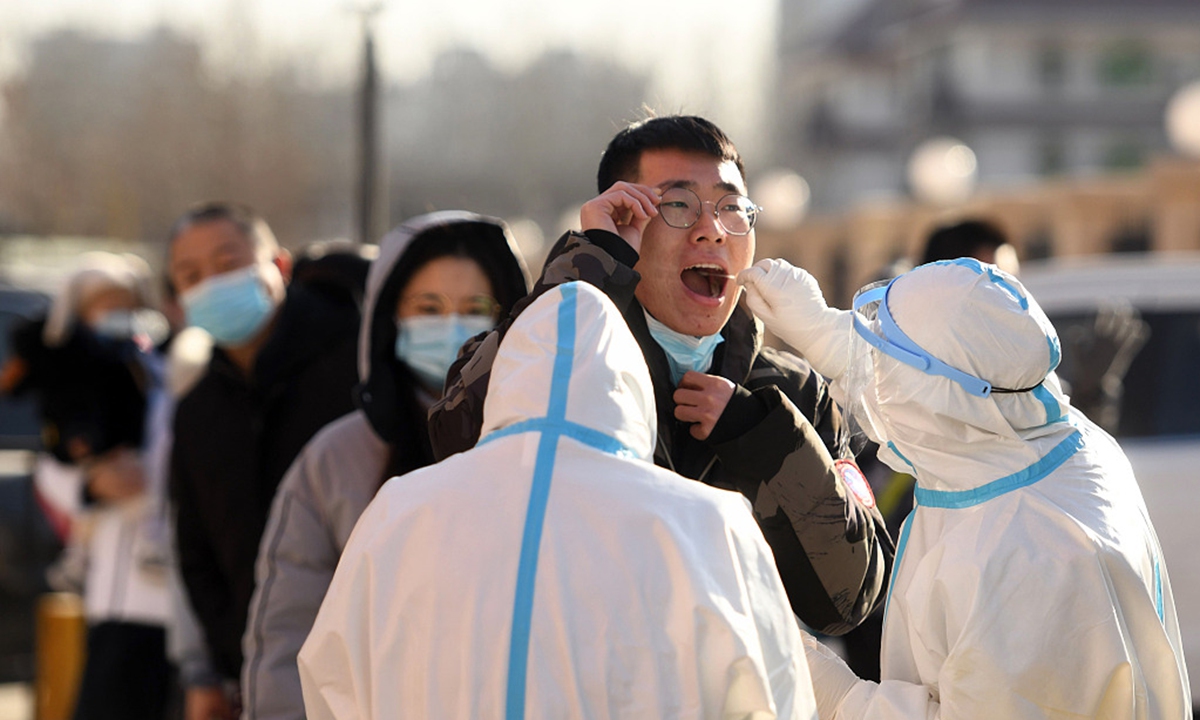
Residents line up to take nucleic acid test at a community in Shijiazhuang, North China's Hebei Province, on January 7, 2021. Photo: VCG
About 22 million people in three cities of Hebei Province neighboring the capital Beijing have been placed under COVID-19 lockdown as of Tuesday, twice the size of the population that was put under lockdown during the Wuhan epidemic, as Hebei has vowed to take resolute measures to prevent the epidemic from spreading to the capital.
The lockdown measures in Hebei cities - Shijiazhuang, Xingtai and Langfang - were not as harsh as Wuhan's as residents in Hebei could go downstairs to pick up their deliveries or purchase food from stores inside their residential communities. Vehicles and people in the three cities are not allowed to leave, unless necessary, Hebei authorities said at Tuesday's news briefing.
Langfang, which is half an hour away by car from Beijing, rolled out citywide nucleic acid testing on Tuesday, and roads linking the city with the outside were put under a 24-hour monitor.
Langfang's Gu'an county neighboring Beijing's Daxing district, where the Beijing Daxing International Airport is located, has imposed seven-day quarantine on its entire 500,000 population and rolled out free nucleic acid tests to residents, after one COVID-19 patient who works in the capital was reported. Sanhe county neighboring Beijing's Tongzhou, Pinggu and Shunyi districts imposes the same lockdown and nucleic acid testing policies.
Residents from other cities in Hebei were encouraged not to enter Beijing amid the outbreak.
Since January 2, Hebei Province has reported a total of 326 COVID-19 cases as of Tuesday, and 234 asymptomatic carriers.
Shijiazhuang, which recorded the most daily new cases in Hebei, started a second round of nucleic acid testing on Tuesday, and the local authority started to move 20,000 villagers from 12 villages of the epidemic-stricken Gaocheng district to other townships for quarantine since Monday after cluster infections of the district's Xiaoguozhuang village turned the entire district into a high-risk zone.
A resident surnamed Yang from Yangma village in Shijiazhuang, 6 kilometers from Xiaoguozhuang village, told the Global Times on Tuesday that the local government started sending villagers to quarantine centers outside their villages on Monday morning.
"We were told that the environment of the village is not safe. Therefore, we have to temporarily move to a safer place," he said, noting that his family is still waiting for the notice of when to move.
He said the village conducted a fourth mass test on Tuesday morning since it was sealed off after the first case was spotted on January 2 in Xiaoguozhuang village.
Chinese health experts said that imposing quarantine for confirmed, asymptomatic cases and close contacts is key to preventing the virus spread. Villages cannot fully implement such quarantine measures, which is why the local government mobilized them to quarantine at designated places, experts said.
Tong Zhaohui, chief physician of the respiratory and critical medicine department at Beijing Chaoyang Hospital, and also an expert on the central government's steering group in Hebei, told the Global Times on Tuesday that the outbreak in Hebei is spreading fast, but the overall situation is controllable.
He said some people in Hebei have tested positive antibodies, meaning they may have already contracted the virus. Normally, antibodies are produced after contracting the virus for at least 10 days or two weeks, he said.
Various provinces and cities across China are tracing local people who may have come into close contact with COVID-19 patients in Hebei, and Central China's Wuhuan and North China's Shanxi Province have reported cases linked to Hebei cluster infections.
The epidemic in Wangkui county, Northeast China's Heilongjiang Province, which has been under lockdown since Monday after dozens of asymptomatic cases were detected, has spread to at least two cities in the province and one city in a neighboring province. Most of these cases were silent infections, sparking concerns that recent domestic outbreaks have seen more asymptomatic infections.
Wang Guangfa, a respiratory expert at Peking University First Hospital, told the Global Times that a majority of asymptomatic patients will gradually show symptoms when they pass their incubation period, then they will be categorized as confirmed patients.
There was no evidence that the number of asymptomatic patients was larger than previous epidemics in China, Wang said.
Wang attributed the emerging asymptomatic patients in Hebei and other provinces to the early detection of those patients.
"When authorities found suspicious cases before they even showed symptoms, they mobilize those people to receive a test and quarantine at the same time. Authorities race ahead of the epidemic," Wang said.
The expert said the percentage of asymptomatic patients is quite small, accounting for less than 1 percent of total cases.




